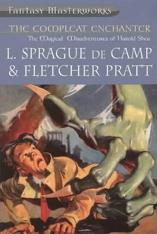
The Compleat Enchanter
L. Sprague de Camp
Fletcher Pratt
420 pages
published in 1975
J. R. R. Tolkien has such a hold on the fantasy genre still, both through writers following in his footsteps and through those consciously rebelling against his influence that it's sometimes hard to remember that there was a fantasy genre before Lord of the Rings. There have always been fantasy writers, from the largely anonymous creators of myths, legends and fairy tales up to serious Victorian writers like Charles Kingsley and Christina Rossetti. And when science fiction was born from the American pulps of the 1920ties, fantasy was right there with it. In fact pulps like Weird Tales, devoted to weird or fantastic stories had existed long before the first decicated science fiction magazine appeared.
Science fiction and fantasy then were even more intertwined than they are today, especially in the subgenre of socalled rationalised fantasy written by the writers working for John Campbell. As you know if you're a proper science fiction fan, John Campbell was the editor who's largely credited by lifting science fiction out from its pulp roots and he attempted to do the same for fantasy through the near-legendary magazine Unknown. The way Cambell and his writers approached fantasy was the same as how they dealt with science fiction, by giving fantasy an internal consistency, coherence and rationale, much less mood based than a lot of older fantasy. In Unknown's brand of fantasy there are rules to be discovered and experimented with. The Compleat Enchanter is one of the best known examples of this genre, with L. Sprague de Camp and Fletcher Pratt having been regular contributors to Unknown for which they the three stories that make up this book.
The Compleat Enchanter has somewhat of a chequered history. It started out as The Incompleat Enchanter, featuring only the first two stories, The Roaring Trumpet (1940) and The Mathemathics of Magic (1940) and was retitled when the third story, The Castle of Iron (1941, expanded in 1950), which was significantly longer, was added. The title is also a bit of a lie: there were two more stories in the series, but due to "contractual obligations" and issues of length these were not included. Which is perhaps for the best, because after 400-plus pages I had enough anyway.
The series stars Harold Shea, a young psychologist, who is bored with modern life and longs for adventure and romance. He's in luck because his collegue Reed Chambers is busy working on a new science called paraphysics, which takes the idea of parallel worlds seriously and which explains away various psychoses as being caused by the patient receiving partial impressions from a different world. Which means that if the shift in impression were to be complete, that person would find themselve in another world altogether, one ruled by different laws of physics. If that world were to be that of classical Greek mythology, it would be governed by the rules of Greek magic. Harold is of course immediately interested and after some experimentation attempts to reach a world build around Irish myths. Unfortunately for him, he instead lands in the world of the Norse sagas, just in time for Ragnarok...
His adventures there are the subject of The Roaring Trumpet and included the famous scene where Harold Shea is imprisoned alongside a madman who every hour on the hour shouts out "Yngvi is a louse" for no apparant reason, which became a sort of fandom injoke. After several misadventures Harold manages to take himself back to the "real world" where he tells the whole story to Reed. Reed is sufficiently impressed to want to go travelling as well and they decide to try and visit the world of Edmund Spenser's The Faerie Queene, which sadly to say I've never read. Nor have I read the setting of the third story, Ludovico Ariosto's Orlando Furioso. Interestingly however, Orlando Furioso was partially the inspiration for Spenser's poem, which plays a part in the problems Harold has in the third story.
In The Mathematics of Magic Harold Shea falls in love with one of the characters of The Faerie Queen, the huntress and evil magician slayer Belphebe, who as Belphegor is also present in Orlando Furioso. At the end of the The Mathematics of Magic Harold had returned with Belphebe to modern America, but Reed had stayed behind to try and cure the woman he loved from a curse. When The Castle of Iron starts, Reed has moved on to the world of Orlando Furiso to find this cure, failed and attempted to "kidnap" Harold and Belphebe to help him, but got only the latter, who promptly took on the character of Belphegor and lost all memory of Harold and her "true identity". A second attempt succeeded in snaring Harold, by way of a detour through Samuel Taylor Coleridge's Kubla Khan and after much adventures both sets of lovers were reunited and free.
I hadn't read The Compleat Enchanter before this, but knew it was a classic fantasy book and as such it was a slight disappointment. It cost me more than a week to read this, largely because I kept hitting sectiosn that caused me to stop reading entirely. I'm not sure why that was, but something in de Camp's and Pratt's combined writing style just bugged me, so I would stop reading or take up antoher book for a while. To be fair, there were also times when I couldn't turn the pages fast enough, but on the whole it was a bit of a slog. Not that this makes it a bad book perse; other people will perhaps have less dificulties with it.
Read more about:
L. Sprague de Camp,
Fletcher Pratt,
The Compleat Enchanter,
science fiction,
book review